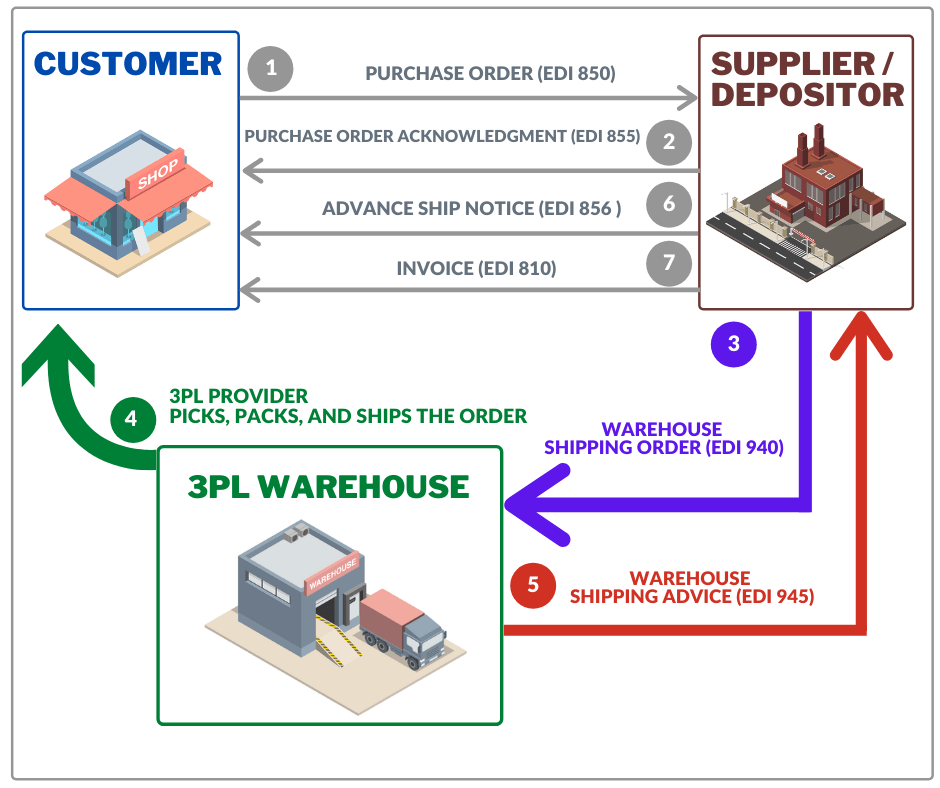EDI 944: Introduction
Welcome to the next part of our series on EDI (Electronic Data Interchange) for logistics. With over two decades of EDI integration experience, we are excited to share our knowledge and insights with you.
In this article, we will look at EDI 944 – Warehouse Stock Transfer Receipt Advice. Our goal is to clarify the complexity and terms associated with EDI in logistics so that it is easier for companies to understand.
Whether you’re new to EDI or looking to brush up on your knowledge, we’re here to help you navigate the complex landscape of EDI documents.
What is an EDI 944 Warehouse Stock Transfer Receipt Advice?
An EDI 944 Warehouse Stock Transfer Receipt Advice transaction set is an EDI document used in stock transfer. This is a kind of electronic receipt that indicates when and where the goods were transported. For example, from a factory to another location, usually a warehouse, DC, or to a logistics provider such as a 3PL (third-party logistics).
Specifically, EDI 944 is used by the receiving location to confirm the receipt of goods.
3PL (Third-Party Logistics): A 3PL is a company that provides logistics and supply chain management services on behalf of other businesses. These services can include warehousing, transportation, order fulfillment, and other aspects of the supply chain. Companies often use 3PLs to outsource certain parts of their logistics operations to experts in the field.
DC (Distribution Center): A DC, also known as a distribution center or a warehouse, is a facility where goods and products are stored before they are distributed to their final destination. Distribution centers play a crucial role in the supply chain by serving as hubs for receiving, storing, and sorting products, which are then shipped to retailers, wholesalers, or directly to consumers. They help in optimizing the distribution process and ensuring that products reach their intended recipients efficiently.
A ‘stock transfer’ is when goods move from a factory or another location to a far-off warehouse or a third-party logistics provider (3PL). Manufacturers often send their products to 3PLs, who then help distribute them to distribution centers (DCs) or, sometimes, directly to retailers.
Exploring the Content of EDI 944 Documents
The EDI 944 typically includes key information such as:
Shipment details: Information about the goods being transferred.
Sender and receiver details: Identifying who’s sending and who’s receiving the goods.
Dates: When the shipment was received.
Quantity: How many items were shipped and how many were received.
Reference numbers: Unique codes to track the shipment.
Notes: Any additional comments or special instructions.
This information helps in tracking and managing the transfer of goods effectively.
Explore the depths of Electronic Data Interchange (EDI) with our detailed video explanation. Start delving into the video now
How Do Businesses Use EDI 944?
Companies use EDI 944 to streamline their inventory and logistics processes. Here’s how:
Inventory Tracking: EDI 944 helps businesses keep tabs on their stock as it moves from one place to another. It ensures that the right products reach the intended location.
Efficient Communication: By using EDI 944, companies can communicate electronically with their warehouses or 3PLs, reducing the need for manual paperwork and phone calls.
Accuracy and Speed: It minimizes errors and speeds up the transfer process because information is transmitted electronically in a standardized format.
Visibility: EDI 944 provides real-time updates on shipment status, enabling companies to make informed decisions about their inventory and distribution.
Compliance: Many trading partners and retailers require the use of EDI 944, so using it helps companies remain compliant with industry standards.
In essence, EDI 944 helps companies manage their inventory and logistics operations more efficiently and effectively.
How to Send Warehouse Stock Transfer Receipt Advice (EDI 944)?
The workflow of EDI 944 typically follows these steps:
Data Preparation: The sender compiles the necessary information in its internal ERP or other business system, including details about the shipment, quantities, dates, and other relevant data. This information is then organized in a predefined format (i.e. CSV, TXT, XML, JSON).
Transmission: The sender transmits the EDI 944 document electronically to the receiver, often via its EDI provider.
Data Translation: The EDI provider’s system translates the incoming document into X12 format and then sends it to the receiver via FTP, sFTP, or VAN.
USEFUL READING: How Do Companies Send EDI Files?
Validation: The receiver’s system validates the received data to ensure it is complete and accurate. This step helps prevent errors and discrepancies in the supply chain.
Processing: Once the data is validated, the receiver’s system processes it to update their inventory records and track the incoming shipment.
Inventory Update: The receiving company updates its inventory and logistics records based on the information provided in the EDI 944 document. This includes confirming the receipt of goods and making necessary adjustments.
Further Action: Depending on the specific logistics and business processes, the receiving company may take further actions, such as distributing the goods to distribution centers or retailers, or using the information for planning and decision-making.
This workflow ensures that information about stock transfer is accurately and efficiently communicated between trading partners, helping them manage their inventory and logistics operations seamlessly.
EDI 944 Comparison with Similar EDI Documents: Common Questions Answered
We often encounter a situation where companies try to understand the differences between EDI 944 and other EDI documents with functions that are similar at first glance. However, each EDI transaction has its own specific purposes and differences. Let’s look at the most frequently asked questions regarding the differences between these EDI Transactions.
What is the Relationship between EDI 943 and EDI 944 Documents?
The EDI 943 and EDI 944 documents are closely related within the context of EDI exchange in logistics and inventory management. Here’s how they are connected:
EDI 943 – Warehouse Stock Transfer Shipment Advice: This document is used to initiate the transfer of goods from one location, often a distribution center or warehouse, to another location, such as another warehouse or a retail store. It serves as an instruction from the sender to the receiver, specifying what products are to be transferred, quantities, and other relevant information.
EDI 944 – Warehouse Stock Transfer Receipt Advice: In contrast, the EDI 944 document is used to confirm and acknowledge the receipt of the goods at the receiving location. It verifies that the transfer has taken place as instructed in the EDI 943. The EDI 944 provides details about what was received, in what quantities, and when it was received.
So, in summary, the relationship between the EDI 943 and EDI 944 is a sequential one. The EDI 943 initiates the stock transfer, while the EDI 944 confirms that the transfer has been completed as specified. Together, they ensure a seamless and well-documented movement of inventory within the supply chain.
What is the Difference between EDI 945 and 944?
The main difference between EDI 944 and EDI 945 lies in their purpose and content:
EDI 945 – Warehouse Shipping Advice:
Purpose: The EDI 945 document is used as an acknowledgment of the shipment (the same like an EDI 856 -Advance Ship Notice). It is typically sent by the warehouse or shipping location to the sender, confirming that the goods have been shipped as instructed.
Content: The EDI 945 provides information about the shipment, including details about the contents, packaging, carrier information, and other data related to the shipment.
EDI 944 – Warehouse Stock Transfer Receipt Advice:
The EDI 944 document is used to acknowledge the receipt of goods at a specific location. It confirms that the transfer of goods, has been completed.
In summary, the EDI 944 focuses on the receipt of goods at the receiving location, ensuring that the transfer is acknowledged and documented accurately. The EDI 945 serves as a confirmation of the shipment itself, providing details about the items being shipped, and other information essential for the sender to track the progress of the goods.
Both documents play crucial roles in inventory and logistics management within the supply chain.

What is the Difference between EDI 944 and EDI 861 Receiving Advice/Acceptance Certificate?
The main difference between EDI 944 (Warehouse Stock Transfer Receipt Advice) and EDI 861 (Receiving Advice/Acceptance Certificate) lies in their specific purposes and use cases:
EDI 944 – Warehouse Stock Transfer Receipt Advice:
Purpose: EDI 944 is primarily used to confirm the receipt of goods when products are transferred from one location to another within the same company or between trading partners. It acknowledges the successful receipt of items after they have been shipped.
Typical Use: It is commonly used in scenarios where goods are moved between warehouses, distribution centers, or third-party logistics providers.
EDI 861 – Receiving Advice/Acceptance Certificate:
Purpose: EDI 861 serves a different purpose, focusing on the acceptance of goods by the buyer or recipient. It indicates that the goods have been received, inspected, and accepted by the recipient, often in the context of a purchase order.
Typical Use: EDI 861 is used in purchase order scenarios, where a buyer confirms the acceptance of products received from a supplier, and it often includes information about the condition of the goods and any discrepancies.
In summary, while both documents involve the acknowledgment of goods, EDI 944 is typically used for internal transfers and stock movements, while EDI 861 is more focused on confirming the receipt and acceptance of products in a buyer-seller relationship, often linked to purchase orders. The choice between using EDI 944 or EDI 861 depends on the specific needs of the business process and the nature of the goods being exchanged.
What is EDI 944 Specification?
The specifications (specs) for an EDI X12 944 transaction set outline the technical details and requirements for its structure and content. These specifications are necessary to ensure consistency and compatibility when exchanging EDI 944 documents electronically between trading partners. Here are some common specifications for an EDI 944 document:
Document Format: The document is typically formatted according to standard EDI guidelines, often using ASC X12 or UN/EDIFACT standards.
Transaction Set Header: The header contains information such as the sender and receiver identification, document type (e.g., EDI 944), date and time of transmission, and a unique control number for tracking.
Repeating Segments and Data Elements: These define the structure of the document, including segments and elements for key information like item descriptions, quantities received, reference numbers, and additional details related to the receipt.
Implementation Guidelines: These guidelines detail how specific industries or trading partners should use the EDI 944 document. They may include additional data requirements or business rules.
Data Elements: Definitions for each data element within the document, describing their purpose and format.
Message Trailer: Similar to the header, the trailer segment contains control information, including a unique control number for verification.
These specifications are essential to guarantee that EDI 944 documents are created and exchanged correctly, ensuring a consistent and accurate flow of information in the supply chain. It’s important to consult the specific standards and implementation guidelines provided by your trading partners to adhere to the required specifications.

Role of EDI Service Providers in Facilitating the Exchange of EDI
EDI service providers play a crucial role in simplifying the exchange of EDI 944 and other EDI transactions for businesses. They offer a range of services designed to streamline the process and ensure efficient communication between trading partners. At EDI2XML, we offer a range of EDI services to meet all EDI needs.
Our EDI Fully Managed Service provides end-to-end support, including document mapping, translation, and data validation. We handle the entire EDI process, from sending and receiving documents to ensuring compliance with industry standards. This service allows businesses to focus on their core operations while leaving the complexities of EDI to experts.
Our EDI Web Service is designed for companies that prefer a self-service approach.
This service allows businesses to quickly begin exchanging EDI transactions (connecting to our service takes no more than an hour) and easily manage their EDI transactions, including EDI 944, with no-contract and on a pay-as-you-go basis.
USEFUL READING: How to Become EDI Compliant in Under 60 Minutes (Yes, Really)
Both services are designed to enhance efficiency, accuracy, and compliance in EDI transactions, making it easier for companies to manage their supply chain and inventory processes.
With the support of EDI service providers, businesses can achieve seamless and error-free communication with their trading partners, ultimately contributing to smoother and more productive operations.
If you’re ready to explore the benefits of our EDI services, whether through our Fully Managed solution or our user-friendly EDI Web Service, we’re here to help.
Contact us today for a free consultation to discuss your specific needs and how we can tailor our solutions to streamline your EDI processes.










